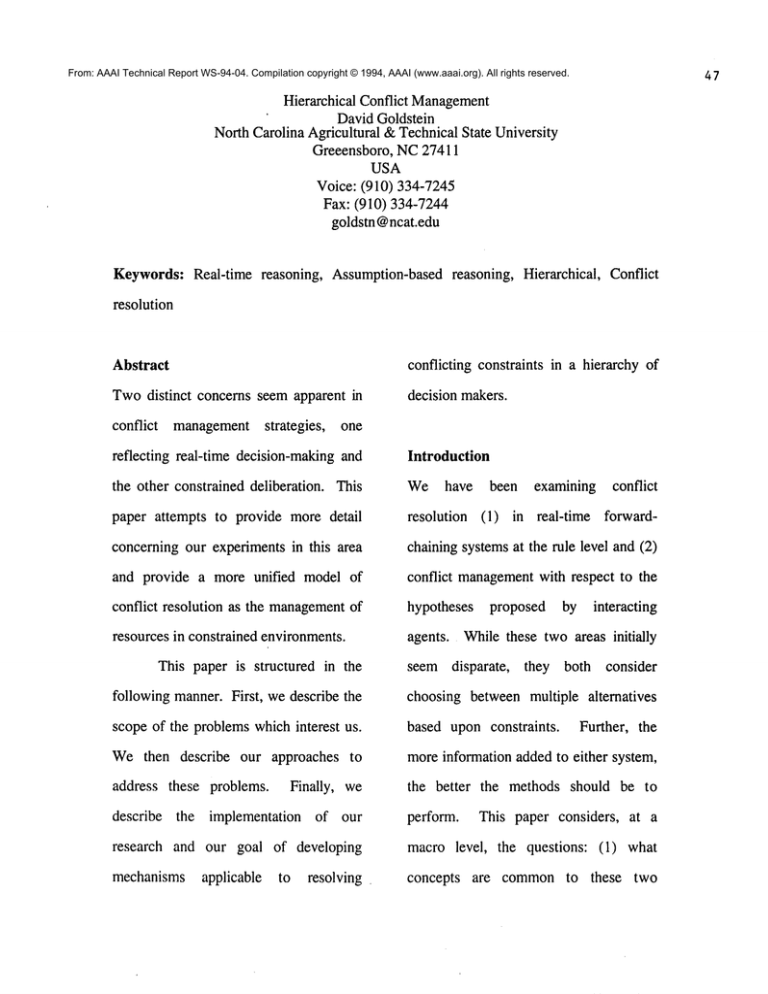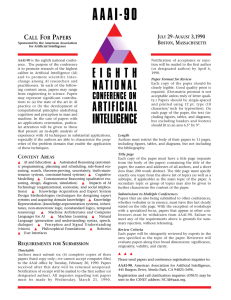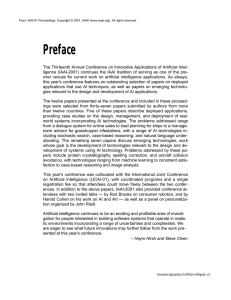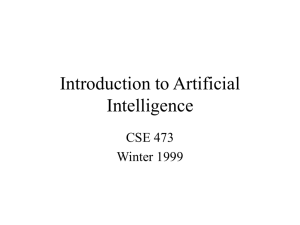
47
From: AAAI Technical Report WS-94-04. Compilation copyright © 1994, AAAI (www.aaai.org). All rights reserved.
Hierarchical Conflict Management
David Goldstein
North Carolina Agricultural & Technical State University
Greeensboro, NC27411
USA
Voice: (910) 334-7245
Fax: (910) 334-7244
goldstn@ncat.edu
Keywords: Real-time reasoning, Assumption-based reasoning, Hierarchical,
Conflict
resolution
Abstract
conflicting constraints in a hierarchy of
Twodistinct concerns seem apparent in
decision makers.
conflict
management strategies,
one
reflecting real-time decision-makingand
Introduction
the other constrained deliberation. This
We have been examining
paper attempts to provide more detail
resolution
concerning our experiments in this area
chaining systemsat the rule level and (2)
and provide a more unified
conflict managementwith respect to the
model of
(1) in real-time
conflict
forward-
conflict resolution as the management
of
hypotheses proposed by interacting
resources in constrained environments.
agents. While these two areas initially
This paper is structured in the
seem disparate,
they both consider
following manner. First, we describe the
choosing between multiple alternatives
scope of the problemswhich interest us.
based upon constraints.
Wethen describe
moreinformation added to either system,
our approaches to
address these problems. Finally,
describe
the implementation
we
of our
the better
the methods should be to
perform. This paper considers,
research and our goal of developing
macro level,
mechanisms applicable
concepts
to resolving
Further, the
the questions:
at a
(1) what
are common to these
two
approaches
and (2).
commonalties
lead
these
can
to a
mechanism for addressing
helping
to meet an application’s
general
deadlines. Morespecifically, we develop
conflict
a partial ordering of actions reflecting a
partial ordering of rule priorities.
resolution in a hierarchical manner.
We
then use these relative rule priorities,
Our Approaches
along with resource dependencies, to
Our initial
develop time-varying priority functions.
time
research stemmedfrom real-
knowledge-based
Initially,
systems.
we attempted to devise clever
These functions are then converted into
spline functions for efficient computation
mechanismsfor "conflict resolution" to
(Figure
1).
We have modified
our
determine the most appropriate chain of
inferencing mechanismsto efficiently
reasoning to pursue amongthe multiple
computethese priorities at run-time[ 1 ].
We examine employing such a
chains currently available to a forwardchaining system. Morespecifically, given
conflict
n satisfied rules in the "conflict set" of a
considering the generation of plausible
forward-chaining reasoning system, how
courses of action and selecting one such
might we choose the most appropriate
course prior to some time t. Wediscuss
rule for execution.
Commonly used
determining the parameters driving the
recency and
dynamicpriorities in [1 ]. Weintend to
approaches,
including
resolution
algorithm
means-endsanalysis, essentially ignore
eventually
the real-time characteristics of problems.
reasoning must take place (measured by
Our approach
individual agenda items (i.e.,
how much
counting and weighing the tokens in the
to conflict
resolution modifies the priorities
also consider
by’
of
rules and
RETE network)
priorities.
to modify the rule
By tying the contents of the
their matching data elements) during
RETEnetwork to the rule priorities,
each reasoning cycle. Weprioritize rules
hope to be able to extend an approach
based upon the likelihood of the actions
we
49
such as that in [2] to predict near-future
management); agents can reason about
behavior of a system.
other agents if their goals require such
knowledge,but if an agent G’s goals are
The above approach seemingly
addresses only the lowest levels
conflict
disjoint
of
from other
agents
then
processing can proceed (with literally
management in a system.
Therefore, we now address developing
hundreds of agents being dynamically
mechanisms for conflict
created or destroyed) without any other
management
agent having knowledge of G. While
amongmultiple, interacting agents.
The mechanisms
numerous conflict
we have
previously used for conflict management
have been
were rather autocratic
negotiation,
[3]. However,
management models
proposed
reflecting
stock markets,
our current experiments in Distributed
playing,
Artificial
exploring is based upon transferring
Intelligence
deal with the
etc.,
game-
the approach we are
extremeof distributed control (and so we
procedural knowledge and assumptions
are devising newstrategies for conflict
amongagents.
Scenario-Specified
Task Criticality
Priority
/
’~
Resource Estimation
(obtainable from
Directed Acyclic
Graph)
~
P(Task will Complete)
Output
Task
~cheduled Useful
Output
Required
Output
Critical
Task
Executed
or No Longer
InstantaneousPriority (Salience)
Figure 1: Prioritizing a Rule via a Spline Function
50
Weview agents as a collection of
given that certain constraints must be
engaged in a dialogue in a
met for this knowledgeto be executed,
entities
canonical language.
contradictory
Periodically,
statements (plans) are
our conflict
management mechanism
removes the low-priority
stated (created). Based upon the actual
from
world, at least one statement fromthe set
corresponding
of all
constraining assumptions. Werepeat this
statements
involved in the
consideration
knowledge
and
the
constraints
and
conflicting
set of statements must be
process until no conflicts are present.
retracted.
Weuse the assumptions to
Wethen choose the remaining statements
determine which piece of the procedural
(decide in favor of the remainingagent’s
knowledgeshould be invalidated first.
courses of action.)
Given a set of resources with
some value
prioritized
per unit
and a set of
goals, procedural knowledge
Weview removing
assumptions as taking one of two forms,
either (1) literally
discarding
the
hypotheses related to the low priority
has a cost associated with achieving each
assumptionsor (2) generating alternative
specific goal. Eachgoal similarly has an
hypotheses
via employing domain-
associated,
independent
mechanisms to achieve
computable benefit.
The
difference between these two quantities
alternative
can be viewedas a net gain in potential
have not yet implementedour library to
resources for having achieved a goal
generate alternatives
(note: one should not be able to utilize
proposed plans, we hope to develop a
negative resources
domain-independent rule-base
nor do we allow
implicit borrowingof resources.)
The net potential resource gains
form an ordering
of procedural
knowledge to be executed.
However,
plans as per [4]. While we
to inconsistent,
to map
domain-specific concepts and classes of
objects
to generally
techniques.
applicable
51
These two conflict
The underlying
resolution
meta-models
strategies mayseemdisparate initially,
(semantics) of data items is an important
but they do have some commonroots;
consideration.
they both examine resource conflicts
the Product Data ExchangeSpecification
using rule-based
(PDES) for our meta-models [7].
develop
techniques.
As we
Weuse an extension of
Our
meta-modelsexhibit our philosophy that
our domain independent
techniques for conflict resolution, we
basic concepts
hope to better understand the conflict
application in a system must first
resolution
described.
process so as to perform
understood
by each
be
Because PDES includes
agenda managementin a more efficient
representations of quantities (such as
manner. Further, we hope to eventually
force,
be able to developa hierarchy of conflict
concepts (such as behaviors, phenomena,
management schemes from the inner-
and physical objects) can be represented.
distance,
and hue) diverse
agent to society-wide levels such that
one can model the resolution processes
Conclusion
using similar mathematicsat each level.
We have presented
two conflict
management schemes operating
at
Status
different levels in a hierarchy of conflict
The agent architecture has been realized
resolution.
as the Distributed Artificial Intelligence
more rigorously in the future to better
Toolkit
understandthe essential characteristics of
(DAIT), a series
of tools
including
an enhanced
version
NASA’s
C Language
Integrated
Production
of
System (CLIPS) [5][6].
conflict
Weintend to model these
managementin a hierarchy of
decision makers. Weintend to use these
schemes to develop domain-independent
Agents can communicate
via facts
conflict resolution mechanismswhich can
(mathematical
templates
be employedat any level in the hierarchy
tuples),
(database records) and objects.
52
by mapping general
mechanisms
Expert,
Miller-Freeman
Publishing, January, 1994, pp 3034.
tO
domain-specific objects and concepts.
[7]
References
[1]
D. Goldstein, "A Fault-tolerant
Agent-based Architecture for
Manufacturing",
Concurrent
Engineering:
Research and
Applications, to appear 1994.
[2]
F. Barachini and H. Mistelberger,
"Run-Time
Prediction
for
Production
Systems",
in
Proceedings of
the Tenth
National Conferenceon Artificial
Intelligence,
American
Association
for
Artificial
Intelligence,
Menlo Park, CA,
July 1992, pp. 478 - 485.
[3]
D. Goldstein and J. Tiernan,
"Domain-independent Conflict
Managementvia Agent-supplied
Metrics", 1993 IJCAI Workshop
on
Conflict Management,
International Joint Conferenceon
Artificial Intelligence, France,
September 1993.
[4]
M. Klein, "Supporting Conflict
Resolution in Cooperative Design
Systems", in Proceedings of the
10th International Workshopon
DistributedArtificial Intelligence,
Bandera, TX, October 1990.
[5]
J. Giarrantano, "CLIPS User’s
Guide", NASA/Johnson Space
Center, Houston, USA,1991
[6]
D. Goldstein, "The Distributed
Artificial Intelligence Toolkit", AI
International
Standards
Organization,
Product Data
ExchangeSpecification, Part 32,
National Institute of Standards
and Technology.





